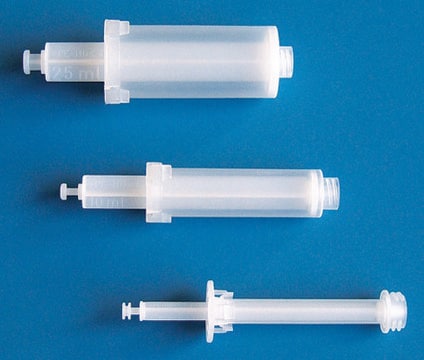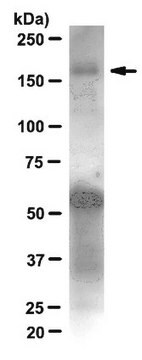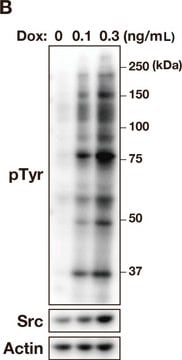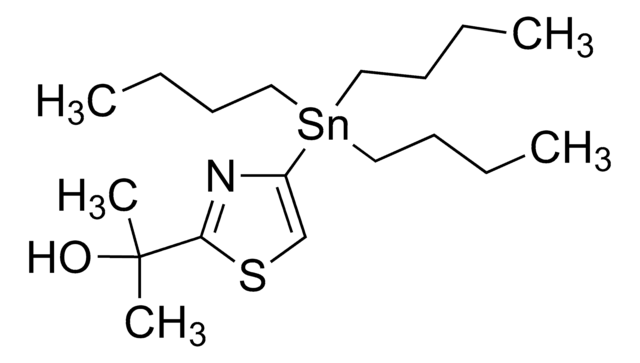05-184-AF488
Anti-Src Antibody, clone GD11, Alexa Fluor™ 488 conjugate
clone GD11, from mouse, ALEXA FLUOR™ 488
別名:
Tyrosine-protein kinase transforming protein Src, pp60v-src, p60-Src, v-Src, Proto-oncogene tyrosine-protein kinase Src, p60-Src, pp60c-src, Proto-oncogene c-Src
ログイン組織・契約価格を表示する
すべての画像(2)
About This Item
UNSPSCコード:
12352203
eCl@ss:
32160702
NACRES:
NA.41
おすすめの製品
詳細
Tyrosine-protein kinase transforming protein Src (EC 2.7.10.2; UniProt P00526; also known as p60-Src, pp60v-src, v-Src) is encoded by the V-SRC gene (Gene ID 1491925) of Rous sarcoma virus strain Prague C (RSV-PrC).
Rous sarcoma virus (RSV) V-SRC gene is the first retroviral oncogene discovered. V-SRC encodes the v-Src tyrosine kinase that transforms infected host cells into uncontrolled mitosis, providing abundant cells for fresh infection. The non-oncogenic chicken c-Src (cellular Src) gene structurally related to v-Src was discovered later in 1979 by J. Michael Bishop and Harold E. Varmus. It is believed that RSV originally took up the chicken proto-oncogene SRC (Gene ID 396442; UniProt P00523) and incorporated into its genome in the mutated concogene form. c-Src contains six functional regions, Src homology 4 (SH4) domain, unique region, SH3 domain, SH2 domain, catalytic domain, and short regulatory tail. In its inactive state, Src is phosphorylated at Tyr527. The pTyr527 interacts with the SH2 domain which helps the SH3 domain interact with the linker domain and consequently keeps the inactive unit tightly bound. Dephosphorylation of pTyr527 destabilizes the inactive conformation, opening up the SH3, SH2 and the kinase domains, leading to Tyr416 autophosphorylation and c-Src activation.
Rous sarcoma virus (RSV) V-SRC gene is the first retroviral oncogene discovered. V-SRC encodes the v-Src tyrosine kinase that transforms infected host cells into uncontrolled mitosis, providing abundant cells for fresh infection. The non-oncogenic chicken c-Src (cellular Src) gene structurally related to v-Src was discovered later in 1979 by J. Michael Bishop and Harold E. Varmus. It is believed that RSV originally took up the chicken proto-oncogene SRC (Gene ID 396442; UniProt P00523) and incorporated into its genome in the mutated concogene form. c-Src contains six functional regions, Src homology 4 (SH4) domain, unique region, SH3 domain, SH2 domain, catalytic domain, and short regulatory tail. In its inactive state, Src is phosphorylated at Tyr527. The pTyr527 interacts with the SH2 domain which helps the SH3 domain interact with the linker domain and consequently keeps the inactive unit tightly bound. Dephosphorylation of pTyr527 destabilizes the inactive conformation, opening up the SH3, SH2 and the kinase domains, leading to Tyr416 autophosphorylation and c-Src activation.
特異性
Clone GD11 reacted with v-Src of Rous sarcoma virus (RSV) strains Prague subgroup A (PrA-RSV), Schmidt-Ruppin subgroup D (SRD-RSV), and Bratislava 77 subgroup C (B77 C-RSV). Clone GD11 detected enzymatically active c-Src from a variety of chicken, rodent, and human cells (Parsons, S.J., et al. (1984). J. Virol. 51(2):272-82).
免疫原
Epitope: Amino acids 82-169.
Recombinant PrA-RSV p60src.
アプリケーション
Research Category
細胞骨格
細胞骨格
Research Sub Category
腫瘍関連タンパク質
腫瘍関連タンパク質
Anti-Src Antibody, clone GD11, Alexa Fluor™ 488 conjugate is an antibody against Src for use in Immunocytochemistry.
Immunocytochemistry Analysis: An 1:100 dilution of this antibody from a representative lot detected Src in A431, HUVECs, and NIH/3T3 cells.
The unconjugated antibody (Cat. No. MAB1618) is shown to be suitable also for Western blotting, immunocytochemistry, immunofluorescence, and immunoprecipitation applications.
The unconjugated antibody (Cat. No. MAB1618) is shown to be suitable also for Western blotting, immunocytochemistry, immunofluorescence, and immunoprecipitation applications.
品質
Evaluated by Immunocytochemistry in HeLa cells.
Immunocytochemistry Analysis: An 1:100 dilution of this antibody detected Src in HeLa cells.
Immunocytochemistry Analysis: An 1:100 dilution of this antibody detected Src in HeLa cells.
ターゲットの説明
~60 kDa observed.
物理的形状
Protein G Purified
Purified mouse monoclonal IgG1 antibody conjugate in PBS with 15 mg/mL BSA and 0.1 % sodium azide.
保管および安定性
Stable for 1 year at 2-8°C from date of receipt.
その他情報
Concentration: Please refer to lot specific datasheet.
法的情報
ALEXA FLUOR is a trademark of Life Technologies
免責事項
Unless otherwise stated in our catalog or other company documentation accompanying the product(s), our products are intended for research use only and are not to be used for any other purpose, which includes but is not limited to, unauthorized commercial uses, in vitro diagnostic uses, ex vivo or in vivo therapeutic uses or any type of consumption or application to humans or animals.
Not finding the right product?
Try our 製品選択ツール.
保管分類コード
12 - Non Combustible Liquids
WGK
WGK 2
引火点(°F)
Not applicable
引火点(℃)
Not applicable
適用法令
試験研究用途を考慮した関連法令を主に挙げております。化学物質以外については、一部の情報のみ提供しています。 製品を安全かつ合法的に使用することは、使用者の義務です。最新情報により修正される場合があります。WEBの反映には時間を要することがあるため、適宜SDSをご参照ください。
Jan Code
05-184-AF488:
試験成績書(COA)
製品のロット番号・バッチ番号を入力して、試験成績書(COA) を検索できます。ロット番号・バッチ番号は、製品ラベルに「Lot」または「Batch」に続いて記載されています。
ライフサイエンス、有機合成、材料科学、クロマトグラフィー、分析など、あらゆる分野の研究に経験のあるメンバーがおります。.
製品に関するお問い合わせはこちら(テクニカルサービス)








